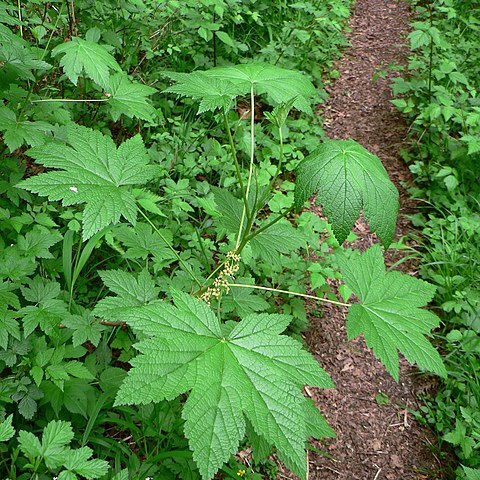Plants 1-4 m. Stems erect, with dense, yellowish, shiny, sessile, crystalline, round glands, sparsely pubescent throughout; spines at nodes absent; prickles on internodes absent. Leaves: petiole 2-10 cm, sparsely pubescent; blade ovate, deeply 5-7-lobed, cleft 1/2+ to midrib, (1.5-)2-10(-22) cm, base cordate, surfaces with yellow, dull, sessile glands and sparse hairs abaxially, with yellow, shiny, sessile glands and glabrous adaxially, lobes with main segments ovate-lanceolate, margins 1-2 times sharply serrate, apex acute, shallowly lobed. Inflorescences ascending to erect, 20-50-flowered racemes, (10-)15-30 cm, axis sparsely pubescent, flowers evenly spaced. Pedicels jointed, 5-12 mm, pubescent and glandular; bracts conspicuous, proximal ones ovate, lobed, distal ones narrowly oblong, unlobed, (3-)4-5 mm, sparsely glandular and pubescent. Flowers: hypanthium green, saucer-shaped, widely flared, 0.5-1.5 mm, ± pubescent and sparsely glandular abaxially, glabrous adaxially; sepals nearly to somewhat overlapping, spreading, brownish purple to greenish or sometimes nearly white, ovate-lanceolate to oblong-lanceolate, 3-5 mm; petals widely separated, erect, white, cuneate-flabelliform, not conspicuously revolute or inrolled, 1 mm; nectary disc wine red, thick, lobed, covering and submerging ovary; stamens slightly longer than petals; filaments linear to slightly broader at base, 1 mm, glabrous; anthers white, transversely oblong-cordate, 0.5 mm, broader than long, apex shallowly notched; ovary somewhat hairy and densely sessile-glandular; styles connate 1/4-1/2 their lengths, 1 mm, glabrous or hairy. Berries bland, black, subglobose, 8-10 mm, glandular. 2n = 16.
More
An erect, scraggly shrub. It grow 2-3 m tall. The bark is grey and dotted with yellow glands. The leaves are large. They have 5-7 lobes. There are teeth around the edge. The plant has a musky odour. The flowers are small and white to green. They are in long erect clusters. The berries are round and blue. They have a waxy coat. The fruit are edible but the taste varies.

